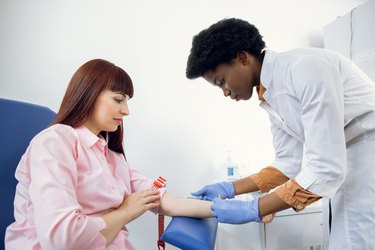
If you're trying to understand the difference between phospholipids and triglycerides, we've got you covered. Here's what you need to know about how these two lipids differ and their distinct roles and functions in the body.
Phospholipids and Triglycerides: Lipid Sisters
Video of the Day
The link between triglycerides and phospholipids is that both are lipids, says Russell de Souza, ScD, RD, registered dietitian, nutritional epidemiologist and associate professor at McMaster University in Hamilton, Ontario, Canada.
Video of the Day
All lipids "are molecules that include fats, waxes and some vitamins, among others," de Souza says.
Lipids are an integral part of cell structure and key to ensuring proper body function, according to the University of Michigan. But the role of these two lipids differs dramatically.
For Phospholipids, Design Equals Function
Phospholipids are "the main component of the cell membrane," de Souza says, fashioned by the body out of the food you eat.
Phospholipids are found in all plant and animal cell membranes, according to a January 2012 study in Lipids in Health and Disease. And as "the structural basis of all cell membranes," de Souza says, "we need phospholipids to keep our cells healthy."
Their secret sauce? Structure. "Each phospholipid is made up of two fatty acids, a phosphate group and a glycerol molecule," de Souza says. That makes it a complex lipid, according to Western Oregon University (WOU).
"When many phospholipids line up, they form a double layer that is characteristic of all cell membranes," de Souza says.
Think of a pin, he says. One end — the head — is attracted to water and is polarized, meaning it packs an electric charge. The other end — the tail — is made up of two fatty acids whose fat composition shifts to "reflect the type of fat in our diet," whether that be saturated, polyunsaturated or monounsaturated fat. It packs no electric charge, isn't attracted to water and doesn't dissolve in water, he says, though it does dissolve in fat.
That head-tail combination is a cell membrane building block made in heaven, de Souza says. "The polar head faces out on each surface to interact with water, and the neutral tails face inward, pointing toward one another."
The result is an interlocking lipid-based "bilayer" that ensures the structural integrity of all your cell membranes.
Triglycerides: Energy on Tap
Not to be outdone, triglycerides are also "essential," de Souza says, as they course through the bloodstream before being stored in fat cells.
Considered a simple lipid, triglycerides, per WOU, are formed by just two constituent parts: glycerol and three fatty acids.
Just like the tail end of a phospholipid, a triglyceride's fatty acid component lacks an electric charge and isn't attracted to water. Yet unlike a phospholipid, triglycerides serve as an ever-ready source of energy between meals, per the Mayo Clinic.
Where do they come from? Breakfast, lunch and dinner. "Most of the fats we eat — including butter, margarines and oils — are in triglyceride form," de Souza says.
Plus, anytime we take in more calories than we need, the body immediately turns the excess into triglycerides, according to the Mayo Clinic. They're then stored in fat cells for future use.
Read more: What Do Rising or Falling Triglyceride Levels Mean?
The High Triglyceride Problem
But therein lies a problem: high triglyceride levels.
"While phospholipids are not something I would worry about from diet," de Souza says, high triglycerides are typically the result of eating or drinking too much sugar, simple carbohydrates and/or alcohol.
They're the stuff body fat is made of, according to WOU. "(And) if the amount of triglycerides circulating in our blood is too high," de Souza says, "our risk of heart disease and diseases of the pancreas increase."
Concern starts when triglyceride levels head north of 150 milligrams per deciliter (mg/dL), according to the Mayo Clinic. Sometimes accompanied by obesity, type 2 diabetes and arterial hardening (arteriosclerosis), high levels up the risk for strokes and heart attacks.
Blood tests can catch the problem, according to the Cleveland Clinic, and diet changes and medications (such as statins and fibrates) can help bring high triglyceride levels back under control.
Read more: How to Prep for a Cholesterol Test
- Russell de Souza, ScD, RD, registered dietitian; nutritional epidemiologist; associate professor, Health Research Methods, Evidence, and Impact, McMaster University, Hamilton, Ontario, Canada
- University of Michigan: Michigan Medicine: “Lipid Panel”
- Lipids in Health and Disease: “Health Effects of Dietary Phospholipids”
- Western Oregon University: "The Major Macromolecules: 11.1 Introduction: The Four Major Macromolecules”
- Mayo Clinic: “Triglycerides: Why Do They Matter?”
- Cleveland Clinic: “Triglycerides & Heart Health”